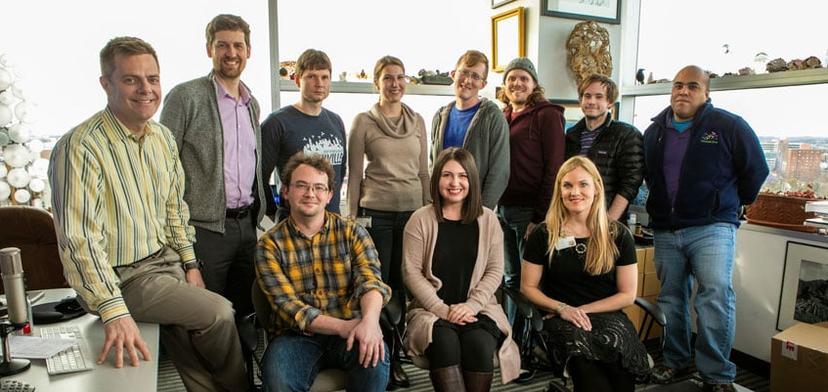Pandemic Prevention: The Sprint Toward Protective Antibody Treatments
Meet the scientists on a mission to ensure effective medical countermeasures in the event of a global viral outbreak
5 Jun 2019
From those exposed to Rift Valley Fever in Kenya or Ebola survivors from Liberia or Nigeria, researchers at the Vanderbilt Vaccine Center scour the planet looking for human donors exposed to infectious agents in order to isolate PBMCs, understand as much as possible about B cell responses to pathogens, and ultimately identify and produce antibodies for use as potential complements to vaccines. “One of the key pillars to what we do is that we're committed to using the actual human immune system as the basis for all our studies, rather than a model system or in vitro modeling,” explains Dr. Robert Carnahan, Associate Professor of Pediatrics and Director of Research in the Crowe lab, at the Vanderbilt University Medical Center Vaccine Center. “We use those at times as tools, down the road, but at the birth of all our projects is the human immune system. By just studying those B cells and the antibodies they make, you can learn a lot about what it takes to be a protective antibody.”

While the team maintains maximum agility and flexibility to collect the highest quality cells possible from donors, focusing on pathogens that might be important locally or globally at a given time is also of crucial importance. This mission has seen the team at the Vaccine Center join the Pandemic Protection Platform (P3) program, leading a collaboration of five institutions working toward effective medical countermeasures in the event of a viral outbreak for which the world is not currently prepared. The P3 program aims to prevent pandemics resulting from potentially lethal viral diseases by delivering human therapeutic options in as few as 60 days.
The program, supported by the U.S. Defense Advanced Research Projects Agency (DARPA), aims to develop protective antibody responses that could effectively deal with a novel or newly emerging infectious disease as quickly as possible. “There are many things that could generate instability around the world. But one of those could be an unpredictable or pandemic [viral] explosion which we were not prepared to adequately contain. That could introduce dangers not only for our military, but also diplomatically and for U.S. citizens and citizens of the world,” explains Dr. Carnahan.
Even if we knew the therapeutic antibody on day one, to be able to produce and validate sufficient protein antibody to deliver 2,000 or 20,000 doses in an initial response is probably not possible within a 60-day timeframe.
Dr. Robert Carnahan Vanderbilt University Medical Center Vaccine Center
The approach
To achieve its ambitious targets, Dr. Carnahan and Dr. James Crowe, Director of the Vanderbilt Vaccine Center, are leading a large collaborative team which employs a nucleic acid-based approach, and includes investigators from Vanderbilt, the Infectious Disease Research Institute, Washington University in St. Louis, Beth Israel Deaconess Medical Center, and the Ragon Institute. Compared to traditional methods, this approach could improve turnaround times of antibody production and quality control and offers opportunities for long-term storage and stockpiling. With such a tight timeframe, minimizing antibody discovery time is key, explains Dr. Carnahan. “The process has to be compressed into at most 30, 40 days, because then downstream of that is in vitro validation, production of RNA material for RNA delivery, and ultimately, in vivo validation of the RNA-delivered form of the antibody.”
The challenge is that a lot of time is spent in methods and technology development, when approaches are tested and refined alongside capabilities demonstrations, known as sprints. Starting with human donor samples from people exposed to Zika virus, the team’s current sprint focuses on getting from donor sample to ready-to-deliver RNA doses during a short 90-day discovery phase. That’s why selecting the right technology is vital to optimize the workflow. Labeling donor B cells and utilizing flow cytometry are at the forefront of this process, and it is important to isolate the right cells the first time.
Key to this, mentions Dr. Carnahan, is Sony Biotechnology’s cell sorting system. "A lot of the Sony's contribution to our workload happened within the very first hours of this sprint, when we had human samples and were trying to quickly get to the B cells that were specific to the Zika response. Sony basically got us there. The key part is that you have got to get to the right cells that are ultimately going into a sequencing pipeline and give rise to the antibody sequences you pursue. Mistakes or hold-ups affect or undermine the entire process, which could actually lead to loss of days or weeks.”
Two of the big benefits to this way of working are the Sony system’s agility and chip-based processing, which make transitioning between experiments quick and enable rapid recovery and experimental optimization. But that’s not all the cell sorter has to offer.
Instant experts
With multiple sprints, and a large collaborative team, new methods can be developed and implemented without reliance on the expertise of just a few individuals. Explaining more about the benefits of the Sony SH800 cell sorter, Dr. Carnahan says, “It handles the more physical, mechanical aspects of the process that, in the past, really took a higher level of expertise to be able to approach. We can get our scientists, who may not be complete flow experts, but really do have a lot of insight into the underlying goals of the science, and convert them into experts.”
With flow cytometry and cell sorting applicable across the entire Vaccine Center, Dr. Carnahan adds, “We needed a technology where we can train up people who literally have little to no flow cytometry expertise, but are able to effectively execute critical flow-based processes, for example, diving into a heterogeneous population of cells with respect to how much or whether they are even still making the antibody at all and separate out those non-producers or low producers from the higher producers, so we can continue to use those as a source of the antibody.”
Agility is vital
The need to maintain complete control of the development process is critical, and the agility of the instrument when it comes to creating new labeling strategies within a simplified workflow is key. “Given that it's a pandemic response, it's the agility that becomes really important,” says Dr. Carnahan. “We can't take any chances there. We must have unfettered access to the instrument and have confidence that it can do what we want it to do. And so, in that sense, that’s why we went with the Sony.”
A benefit of chip-based cell sorting, such as that of the Sony SH800, is that transitioning from one experiment to the next is a quick process, with automation making key steps of instrument setup and operation a streamlined process. “The ability to interactively crank through a new method development process has been important for us, both when we had longer timelines where we can cycle through options, but then also when you're in a very pressure-packed situation, where if something happens to go wrong, you can reboot the process in a matter of minutes and be back up and running without having to go through a more lengthy recycling of the instrumentation to be ready to initiate another process,” explains Dr. Carnahan.
An exciting future
“There are novel findings around antibody sequences where we may be able to adjust and modulate them, so we may be able to get things like 90-day half-life antibodies. With the right dosing, we think those could actually convert into effective protective levels of a neutralizing antibody for 180 days, or even longer. So there are opportunities there, particularly with seasonal viruses,” says Dr. Carnahan.
Of key focus to the Vaccine Center is how antibodies play a complementary role to the vaccine design process, with the regulatory pathway to antibody approval being much simpler, more straightforward, and with a potentially better safety profile. “We like the idea of bringing together the vaccine and the antibody. Think about a global pandemic. Wouldn't it be awesome if the first responders going into that event, not only were giving an effective vaccine, which may take weeks or months to actually be effective, but we were simultaneously giving them a protective antibody, which within hours is protective and has a long half-life? So, we're giving them essentially instant protection until the vaccine has been able to induce long-term immunity. We love this idea of not one or the other, but how can we be thinking about these as a combined strategy to bring together vaccines and antibodies? We're super-excited about that idea,” concludes Dr. Carnahan.
Want to know more?
We asked specialists, Dr. Pavlo Gilchuk and Dr. Matt Goff from the Vanderbilt University Medical Center Vaccine Center, for insider knowledge on getting the best from the Sony SH800 system.
Which chip types do you find particularly useful in your research?
We currently use both 100-µm and 130-µm chips. During initial testing, no difference between the chips was seen. However, we have more recent evidence to suggest the 100-µm chip is better suited to single-cell hybridoma sorts. We routinely use 130-µm chips for bulk memory B cell, plasmablasts, and plasma cell sorts. Be sure to repeat experimental settings several times and with several samples to optimize cell viability and purity.
Are there any special buffers or considerations pre/post sort?
This depends on the experiment. We routinely use low protein concentration buffer (PBS/0.04% BSA) for pre/post-sort samples for procedures that require B cell sequencing analysis. Hybridoma cells are sorted directly into hybridoma growth medium (Medium E), and primary B cells are sorted directly in culturing medium (Medium A).
What type of post-sort assays are you using, for example, functional assays?
Antigen ELISA from supernatants of clonal single-cell sorted hybridoma lines to assess secretion of antigen-specific monoclonal antibodies
NGS and 10x Genomics Chromium sequencing analysis of sorted human B cell subsets
In vitro expansion of sorted memory B cells and antigen-binding ELISA from supernatants to assess production of antigen-specific antibodies
Functional validation of monoclonal antibodies after their recombinant expression, that included binding, neutralization, and in vivo animal testing assays.

